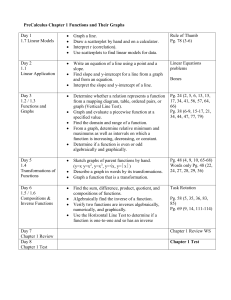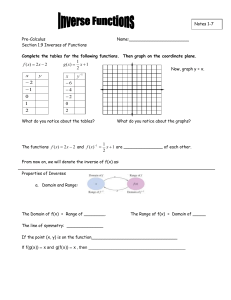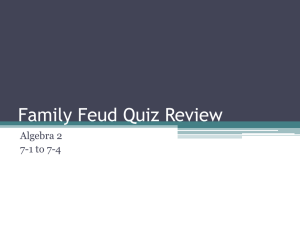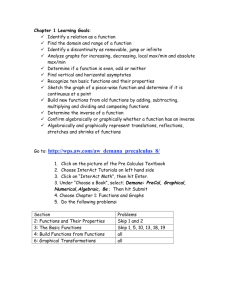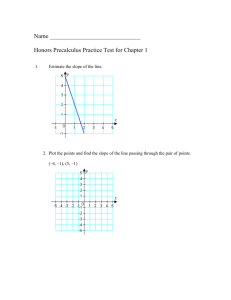Pre-Calculus Assignment Guide 1 Chapter
advertisement
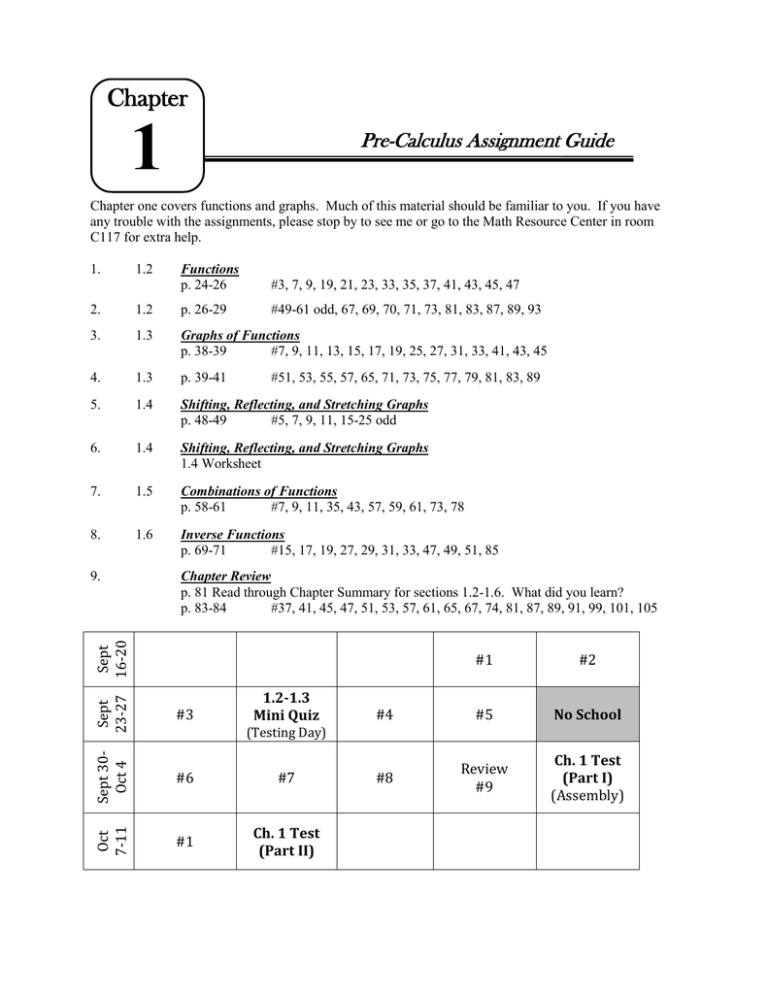
Chapter
1
Pre-Calculus Assignment Guide
Chapter one covers functions and graphs. Much of this material should be familiar to you. If you have
any trouble with the assignments, please stop by to see me or go to the Math Resource Center in room
C117 for extra help.
1.
1.2
Functions
p. 24-26
#3, 7, 9, 19, 21, 23, 33, 35, 37, 41, 43, 45, 47
#49-61 odd, 67, 69, 70, 71, 73, 81, 83, 87, 89, 93
2.
1.2
p. 26-29
3.
1.3
Graphs of Functions
p. 38-39
#7, 9, 11, 13, 15, 17, 19, 25, 27, 31, 33, 41, 43, 45
4.
1.3
p. 39-41
5.
1.4
Shifting, Reflecting, and Stretching Graphs
p. 48-49
#5, 7, 9, 11, 15-25 odd
6.
1.4
Shifting, Reflecting, and Stretching Graphs
1.4 Worksheet
7.
1.5
Combinations of Functions
p. 58-61
#7, 9, 11, 35, 43, 57, 59, 61, 73, 78
8.
1.6
Inverse Functions
p. 69-71
#15, 17, 19, 27, 29, 31, 33, 47, 49, 51, 85
Chapter Review
p. 81 Read through Chapter Summary for sections 1.2-1.6. What did you learn?
p. 83-84
#37, 41, 45, 47, 51, 53, 57, 61, 65, 67, 74, 81, 87, 89, 91, 99, 101, 105
#3
1.2-1.3
Mini Quiz
#1
#2
#4
#5
No School
#8
Review
#9
Ch. 1 Test
(Part I)
(Assembly)
Sept 30Oct 4
(Testing Day)
#6
#7
Oct
7-11
Sept
23-27
Sept
16-20
9.
#51, 53, 55, 57, 65, 71, 73, 75, 77, 79, 81, 83, 89
#1
Ch. 1 Test
(Part II)
Answers to Even #’s
Assignment #2
70 a.1024
cV
. 4 x3 96 x 2 576 x
0 x 12
Assignment #6
Chapter Review
1
78 a. r x
2
2
b. A r
74 a. f ( x) x 2
c. A
x2
4
b. v.s. down 2, h.s. right 3
c. check graph on calc
d . h( x) f ( x 3) 2
Chapter 1 Targets
Functions and Their Graphs
Major Objective: Analyze functions, their graphs, and their inverses.
Section 1.2 Evaluate functions and find their domains.
1.
Decide whether relations between two variables represent a function.
a. Does the equation
x 2 2 y 5 represent y as a function of x?
b. Does the equation
x 3 y 2 5 0 represent y as a function of x?
c.
x 3 y 2 5 y 7 represent x as a function of y?
Does the equation
2. Use function notation and evaluate functions.
a. given:
b. given:
3.
3x 2
, find f (4) , f (0) , f (5)
x2 5
f ( x)
x 2
3x 5,
, find f (4) , f (0) , f (5)
g ( x) 2
x 2 x 1, x 2
Find the domains of functions.
Find the domain of each of the following:
a.
f ( x)
3x 2
x2 5
d. Do the functions
b.
f ( x)
f ( x)
4
x3
c.
f ( x)
x
1
2
x 1 x 4
3x 2
and g ( x) 3 x have the same domain?
x
4. Use functions to model and solve real-life problems.
a . A company produces a toy for which the variable cost is $12.30 per unit and the fixed costs are $98,000. The
toy sells for $17.98. Let x be the number of units produced and sold.
i. The total cost for a business is the sum of the variable cost and fixed costs. Write the total cost C as a
function of the number of units produced.
ii. Write the revenue R as a function of the number of units sold.
iii. Write the profit P as a function of the number of units sold. (note: P = R – C)
b . A baseball is hit at a point 3 feet above the ground at an initial velocity of 100 feet per second and at an angle
of 45o. The path of the baseball is given by the function f ( x) 0.0032 x x 3 where y and x are
measured in feet. Will the baseball clear a 10-foot fence located 300 feet from home plate?
2
Note: there are many great examples in section 1.2 #69 – #82.
5 Evaluate difference quotients.
f ( x m) f ( x )
, m0
m
a. given:
f ( x) 3x 2 find
b. given:
f ( x) x 2 2 x 1 find
f (1 c) f (1)
, c 0
c
Section 1.3 Analyze graphs of functions.
6. Find the domains and ranges of functions and use the Vertical Line Test for functions.
b.
f ( x) 3x 2 . Is the relation a function?
Find the domain and range of f ( x) 3 5x 4 7 . Is the relation a function?
c.
Find the domain and range of f ( x) 2
d.
What is a method that we can use to look at a graph to determine if it is a function?
a.
Find the domain and range of
12 x 4 . Is the relation a function?
7. Determine intervals on which functions are increasing, decreasing, or constant.
a.
c.
f ( x) 3 x 2
f ( x) 5 x 1
b.
d.
f ( x) 3 x 3 4 x 2 x 5
f ( x) 3
8. Determine relative maximum and relative minimum values of functions.
a.
f ( x) 4 x 2 x 5
b.
f ( x) 3 x 3 4 x 2 x 5
9. Identify and graph step functions and other piecewise defined functions.
Sketch the graph of each piecewise function.
a.
x 1, x 0
f ( x)
2 x, x 0
c.
3x 2, , 1
f ( x)
x 3, 1,
b.
x 1, x 3
f ( x) x 1, 3 x 0
x2 ,
x 0
d.
3, (,2)
f ( x) x, [2, 5)
1 [5, )
10 Identify even and odd functions.
Algebraically determine whether the function is even, odd, or neither.
a.
f ( x) 4 x 2 x 5
c.
f ( x) x x 5
b.
f ( x) 3 x 3 4 x 2 x 5
Given (7, -2) is a point on the graph,
d. find the coordinates of a second point if the function is odd.
e. find the coordinates of a second point if the function is even.
Graphically determine whether the function is even, odd, or neither.
f.
f ( x) x 2 5
g.
f ( x) x 2 2 x 3
h.
f ( x) x 3 2
i.
f ( x) x 2 2 x
Section 1.4 Identify and graph shifts, reflections, and non-rigid transformations of functions.
11. Recognize graphs of common functions and use vertical and horizontal shifts and reflections to
graph functions.
a. graph
f ( x) 2(x 5) 2 3
quadratic function
b. graph
f ( x)
square root function
c.
f ( x) ( x 2) 4
cubic function
d. graph
f ( x) 3 ( x 4) 2
cube root function
e. graph
f ( x) x 2 4
absolute value function
f.
( x 2) 1
3
graph
graph
g. graph
f ( x) 2 x 3 1
greatest integer function
f ( x)
rational function
1
x2
3
f ( x) 3 x1 4
f ( x) [ x 2 ] 4
f ( x ) [ | x 3| ] 1
h. graph
exponential function
i.
graph
j.
graph
k.
Describe the effects – stretches, squeezes, shifts of A, B, C & D of y = A | Bx + C | + D
12. Determine the domain and range of the transformations of the parent functions
a. Find the domain and range in each of the functions in target 11 above.
Section 1.5 Find arithmetic combinations and compositions of functions.
13. Add, subtract, multiply, and divide functions and determine the domain of each.
Given: f(x) = 3x2 + 4x – 5
g(x) = 2x – 1
a.
find:
f g x f ( x) g ( x)
b.
find:
c.
find:
d.
find:
f g x f ( x) g ( x)
fg x f ( x) g ( x)
f
f ( x)
x
g ( x)
g
14. Find compositions of one function with another function and determine the domain of each.
Given: f(x) = 3x2 + 4x – 5
g(x) = 2x – 1
a.
find:
f g x f ( g ( x)) and determine the domain.
b.
find:
g
f x g ( f ( x)) and determine the domain.
c.
g ( x) x 3
f ( x) 2 x 4 x 2
find:
f g x f ( g ( x)) and determine the domain.
d.
find:
e.
Write the function h( x)
f.
Write the function
Given:
g
f x g ( f ( x)) and determine the domain.
(2 x 3) as a composition of two functions.
h( x) x 5 x 5 22 as a composition of two functions.
2
15. Use combinations of functions to model and solve real-life problems.
a. A pebble is dropped into a calm pond causing ripples in the form of concentric circles. The radius (in feet) of
the out ripple is given by r(t) = 0.6t, where t is the time (in seconds) after the pebble strikes the water. The
area of the circle is given by
A(r ) r 2 . Find and interpret A r t .
b. An air traffic controller spots two planes at the same altitude flying toward each other. Their flight paths form
a right angle at point P. One plane is 150 miles from point P and is moving at 450 mph. The other plane is
200 miles from point P and is moving at 450 mph. Write the distance s between the planes as a function of
time t.
Section 1.6 Find inverse functions graphically and algebraically.
16. Algebraically determine if the two functions are inverse functions of each other.
a. Are
f ( x) 3x 2
b. Are
f ( x) x 2
c.
f ( x) 4 x 5
Are
d. Are
and
and
g ( x) 13 x 2
g ( x)
and
f ( x) 4 x 3 5
and
x
inverses of each other?
inverses of each other?
x5
inverses of each other?
4
x5
g ( x) 3
inverses of each other?
4
g ( x)
e. What does it take to determine if two functions, f(x) and g(x), are inverses of each other?
17. Use graphs of functions to decide whether functions have inverse functions.
Graphically determine if the following pairs of functions are inverses of each other.
a.
f ( x) 3x 2
and
g ( x) 13 x 2
c.
f ( x) 4 x 5
and
g ( x)
x5
4
g ( x)
b.
f ( x) x 2
d.
f ( x) 4 x 3 5
and
and
x
g ( x)
3
x5
4
18. Use graphical and algebraic tests to determine if functions are one-to-one.
Graphically and algebraically determine if each function is one-to-one.
a.
f ( x) 5 x 3
b.
f ( x) x 2 3
d.
f ( x) 3 2 x 1
e.
f ( x) 2 x 1
2
c.
19. Find inverse functions algebraically.
a.
f ( x) 4 x 3
b.
f ( x) 2 x 1
c
f ( x) 3 3x 5
d.
f ( x) 2 x 1
3
f ( x) 5x 3
Chapter 1 Targets
Answers
1a.
1b.
1c.
2a.
2b.
3a.
yes
no
yes
10a.
10b.
10c.
10d.
10e.
10f.
10g.
10h.
10i
f (4) 1110 , f (0) 52 , f (5) 17
20
f (4) 17 , f (0) 1 , f (5) 36
x : x 5
3c.
3,
x : x 1, 2
3d.
no
4a i.
4a ii.
4a iii.
C = 12.30x + 98000
R = 17.98x
P = 5.68x - 98000
4b.
Yes, the ball is 15 above ground when it passes
the fence.
3b.
5a.
5b.
11a– 11j. Use your graphing calculator to check each of
these.
11k.
B
C
affected by B)
D
Function?
[0, )
Yes
6b.
,
,
Range
, 7
Yes
6c.
,
x : x 2n, nI
12a.
Yes
12b.
6d.
2
3
Vertical line test
Increasing
7b.
23 ,
, 0.738 U
7c.
0.150,
,
7d.
none
8a.
8b.
Relative Minimum
(-0.125, -5.0625)
( -0.150,-5.070 )
| A | > 1 then vertical stretch
| A | < 1 then vertical squeeze
Also, if A < 0 the graph is inverted
12c.
Decreasing
Constant
12e.
none
none
12f.
0.738, 0.150
12g.
none
none
none
none
,
Relative Maximum
None
(-0.738, -4.765)
9a. – 9d. Check with a graphing calculator.
| B | > 1 then horizontal squeeze
| B | < 1 then horizontal stretch
Horizontal shift (this shift is also
Vertical shift
Domain
12d.
7a.
A
vertically
3
4+c
Domain
6a.
neither
neither
neither
(-7, 2)
(-7, -2)
even
neither
neither
neither
12h.
12i.
12j.
.
2,
.
.
.
.
Range
3,
1,
.
.
4,
y : y 2n 1, n I
x : x R, x 2
y : y R, y 3
.
4,
.
y : y n, n I , n 4
.
y : y n,
n I , n 1
,
,
D: ,
13a.
3x2 + 6x – 6
D:
13b.
3x2 + 6x - 6
D:
13c.
6x3 + 5x2 – 14x + 5
13d.
3x 2 4 x 5
2x 1
14a.
12x2 - 4x - 6
D:
14b.
6x2 + 8x - 11
D:
14c.
2 x 3 4 x 12
14d.
4 x 2 2 x 3
D: {x: x ≠ ½ }
0.651, 1.151
14e.
,
,
3,
or 1 413 ,
1 13
4
One possible solution
f ( x) x
and g ( x) 2 x 3
then h( x) f ( g ( x))
14f.
One possible solution
f ( x) x 5
and g ( x) x 2 x 22
then h( x) g ( f ( x))
15a.
A r t 0.36 t 2
15b.
s
200 450t
2
150 450t
2
16a.
16b.
16c.
16d.
no
no
yes
f(g(x)) = x and g(f(x)) = x
17a.
17b.
17c.
17d.
no
no
yes
yes
18a.
18b.
18c.
18d.
18e.
yes
no
yes
yes
no
19a.
f 1 ( x)
x 3
4
19b.
f 1 ( x)
x2 1
2
19c.
f 1 ( x)
x3 5
3
19d.
f 1 ( x)
3
x 1
2
, x>0
